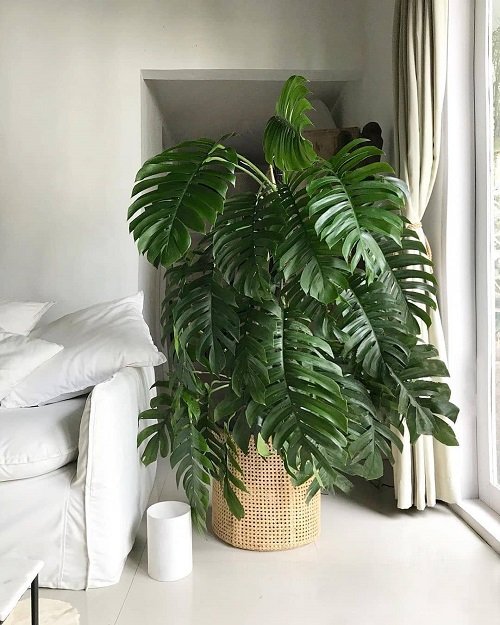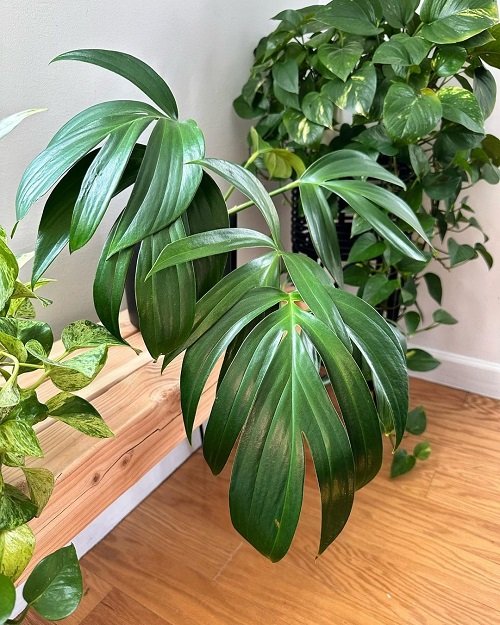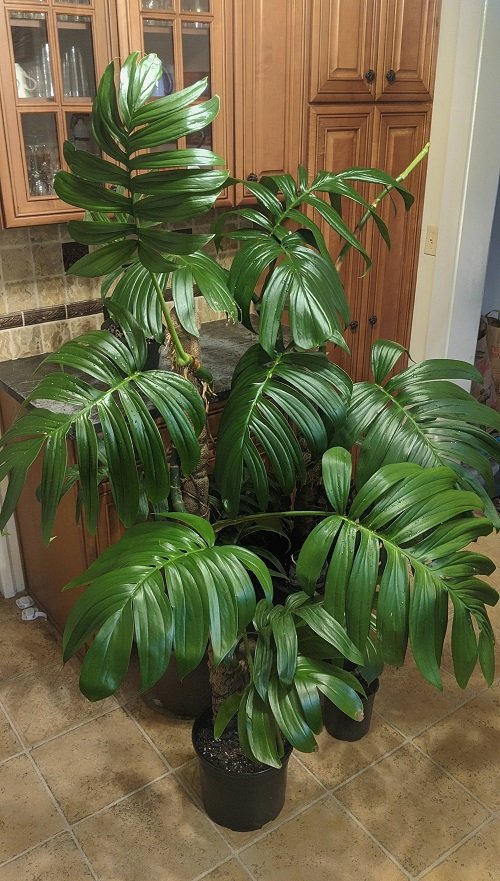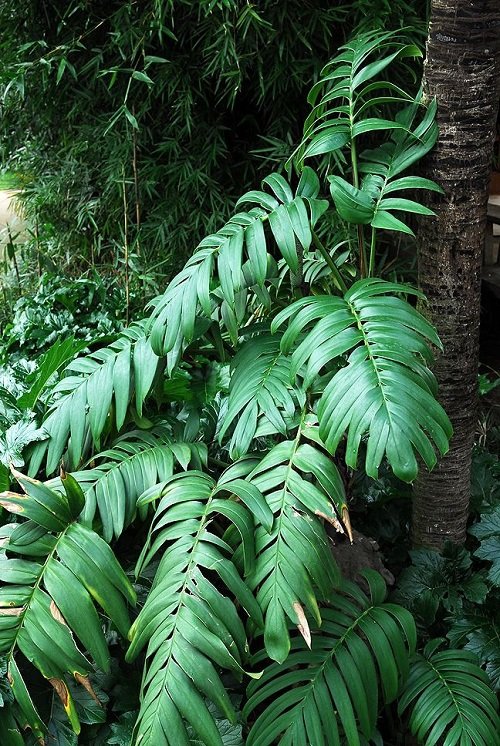Learn How to Grow Rhaphidophora decursiva, a beautiful tropical plant with proper lighting, watering, and humidity.

Discover the secrets of growing Rhaphidophora decursiva, an exquisite tropical plant. Create an ideal environment with ample light, regular watering, and optimal humidity to foster its growth and beauty.
USDA Zones: 9-11
Common Names: Decursiva Plant, Dragon’s Tail, Climbing Philodendron, Creeping Philodendron.
Here is Everything About Growing White Princess Philodendron
Rhaphidophora decursiva Plant Information
Rhaphidophora decursiva, commonly known as “Climbing Philodendron,” belongs to the Araceae family. This beautiful plant is native to Southeast Asia, particularly found in regions like Malaysia and Indonesia.
With its distinctive appearance, Rhaphidophora decursiva showcases large, heart-shaped leaves that have a glossy texture. The leaves are deeply lobed and feature prominent, sinuous veins, adding an enchanting touch to the plant’s appeal. Its lush, green foliage and vigorous climbing habit make it a captivating addition to any indoor or outdoor space.
One of the most striking features of Rhaphidophora decursiva is its ability to produce aerial roots. These roots extend outward from the stem, seeking support as the plant climbs and adding to its unique charm. Additionally, the plant’s mature leaves develop beautiful fenestrations or natural holes, further enhancing its aesthetic allure.
The plant’s luscious foliage and distinct growth pattern make it a captivating focal point that draws attention and admiration.
Check out Philodendron Green Dragon Care and Growing Guide here
Propagating Rhaphidophora decursiva
From Seeds:
- Collect mature seeds from a healthy Rhaphidophora decursiva plant. Clean the seeds by removing any pulp or debris, and rinse them with water.
- Fill a seed tray or small pots with a well-draining potting mix. Place the seeds on the soil surface and lightly press them into the soil.
- Cover the tray or pots with a plastic dome or plastic wrap to create a greenhouse-like environment.
- Keep the soil consistently moist but not waterlogged, using a spray bottle or misting to avoid disturbing the seeds.
- Place the tray or pots in a warm location with indirect light, ideally around 70-80°F (21-27°C).
- Germination may take several weeks to a few months, so be patient.
Follow these Expert Tricks to Germinate Seeds Faster
From Cuttings:
- Select a healthy Rhaphidophora decursiva plant and identify a mature stem with several leaves.
- Using clean, sharp pruning shears, make a clean cut just below a node (the area where a leaf is attached to the stem. Take a 5-6 inches long cutting). Remove any lower leaves on the cutting, leaving a few leaves at the top.
- Prepare a well-draining potting mix or a mixture of peat moss and perlite. Create a small hole in the soil and gently insert the cut end of the stem into the hole.
- Firmly press the soil around the base of the cutting to hold it in place. Mist the cutting and the surrounding soil with water to increase humidity.
- Place the pot in a warm location with bright, indirect light, ideally around 70-80°F (21-27°C).
- Keep the soil consistently moist but avoid overwatering, as it may cause rot. It may take several weeks for roots to develop.
Propagate Any Plant Cutting Quickly Using this Trick
Best Pot Size for Rhaphidophora decursiva
To grow Rhaphidophora decursiva in pots, you can start the plant in a 10 to 12 inches container – it will be good for a few years. After which, you can re-pot the plant in a one size bigger container depending on its growth and spread.
Check Philodendron Fuzzy Petiole Care and Growing Information here
Requirements for Growing Rhaphidophora decursiva
Sunlight
Rhaphidophora decursiva thrives in bright, indirect light. You should place it near a window where it can receive filtered sunlight or in a location with bright, indirect light.
Avoid exposing the plant to direct sunlight, as it can scorch the leaves.
Soil
Use a well-draining potting mix for Rhaphidophora decursiva. It prefers a soil mix that retains moisture without becoming waterlogged.
A combination of peat moss, perlite, and regular potting soil works well. This type of soil allows for proper drainage while also retaining some moisture to keep the plant hydrated.
Learn some Great Tips to Rejuvenate Your Old Soil here
Water
Keep the soil consistently moist but not waterlogged. Water the plant when the top inch of soil feels slightly dry to the touch. Ensure that excess water drains out from the bottom of the pot.
Here are the best ways to water plants
Avoid overwatering, as it can lead to root rot. Rhaphidophora decursiva appreciates slightly more water during warmer months, but you should reduce watering during colder periods.
Temperature and Humidity
Rhaphidophora decursiva thrives in average to warm temperatures between 65-85°F (18-29°C).
It prefers a humid environment, so maintaining higher humidity levels is beneficial. Regularly mist the leaves or place the plant on a pebble tray filled with water to increase humidity. Avoid placing it near drafts or in excessively cold or dry locations.
Here are 10 Ways To Increase Humidity For Houseplants That Work
Rhaphidophora decursiva Care

Fertilizer
Feed Rhaphidophora decursiva with a balanced, water-soluble houseplant fertilizer during the growing season (spring and summer) approximately every two to four weeks. Dilute the fertilizer according to the instructions on the packaging to avoid overfeeding.
Here are Effective Homemade Lawn Fertilizers That Are Safe From Hazardous Chemicals
During the dormant period (fall and winter), reduce or suspend fertilization. Always ensure the soil is moist before applying fertilizer to prevent any potential root burn.
Pruning
Regular pruning helps maintain the shape and size of Rhaphidophora decursiva. You should trim away any yellowed, damaged, or dead leaves as they appear. If the plant becomes too large or leggy, you can snip back longer stems to encourage bushier growth.
Pruning can be done at any time of the year, but spring is generally a good time to perform more extensive pruning. Make sure you use clean, sharp pruning shears to prevent the spread of diseases.
Pests and Diseases
Rhaphidophora decursiva is generally resistant to pests, but it can occasionally be susceptible to common houseplant pests like spider mites, mealybugs, and scale insects.
Regularly inspect the plant for any signs of infestation, such as webs, sticky residue, or visible pests. If detected, treat the affected areas with appropriate insecticidal soap or neem oil, following the product instructions.
Avoid overwatering to prevent root rot, and ensure good air circulation around the plant to minimize the risk of fungal diseases.



